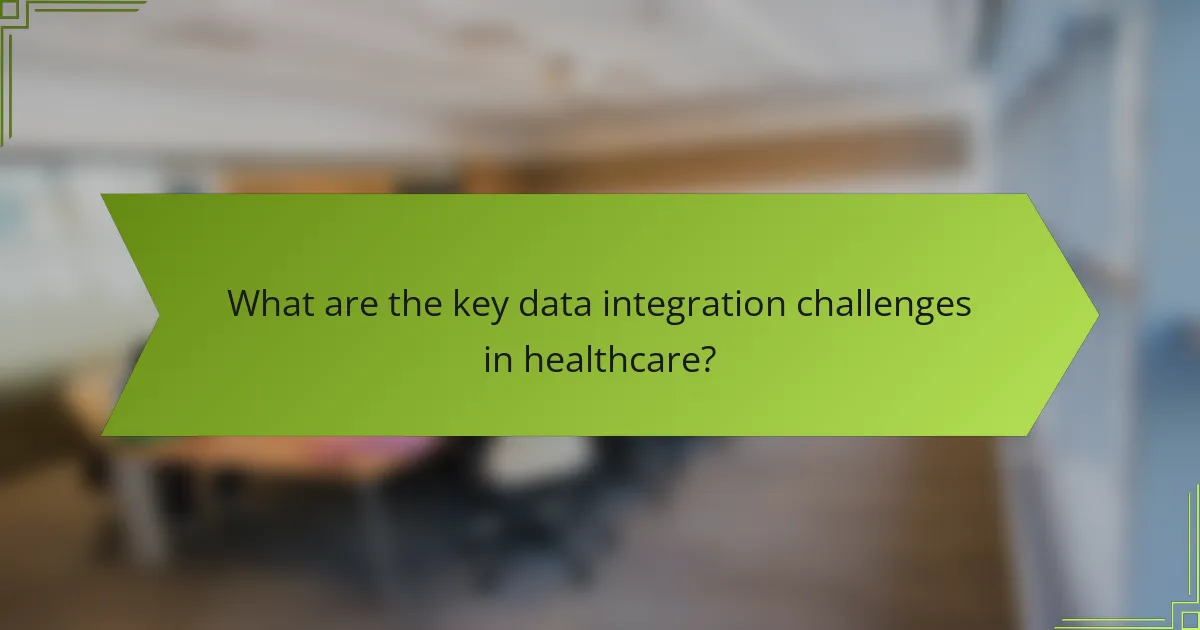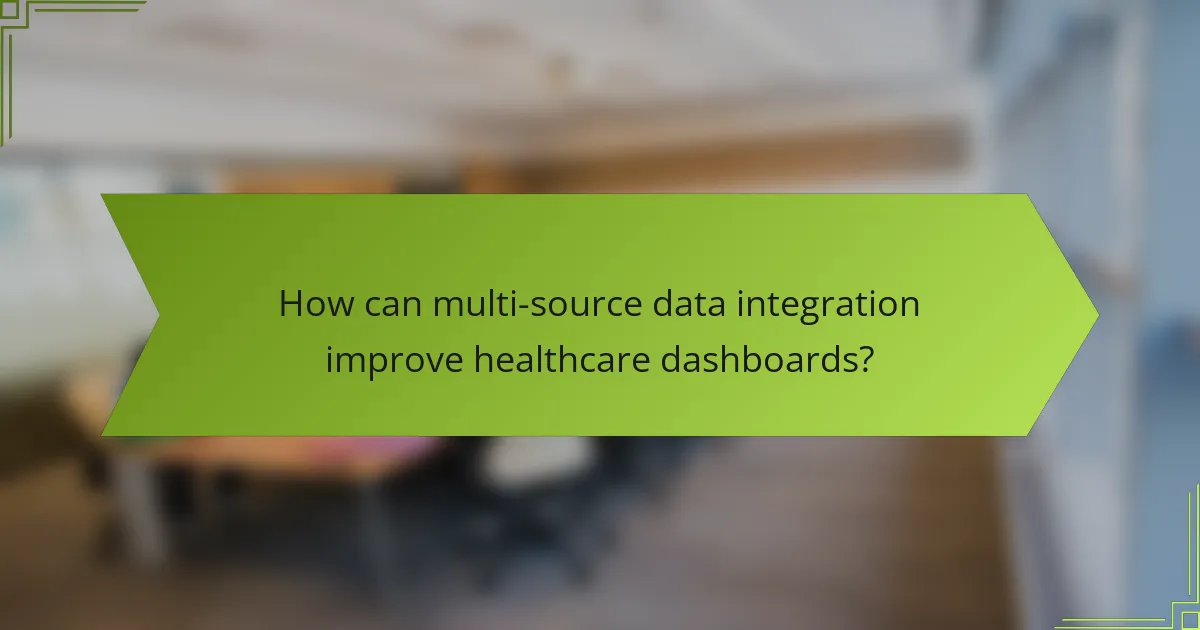Data integration in healthcare is crucial for effective decision-making and patient care, yet it faces significant challenges such as data silos and interoperability issues. By leveraging multi-source data integration, healthcare dashboards can consolidate information from diverse systems, providing comprehensive insights that enhance operational efficiency. This approach not only improves data visualization but also supports better analytics and informed decision-making across healthcare organizations.

What are the key data integration challenges in healthcare?
Data integration in healthcare faces several significant challenges that can hinder effective decision-making and patient care. Key issues include data silos, interoperability problems, concerns about data quality, compliance with regulations, and limitations in scalability.
Data silos
Data silos occur when information is stored in isolated systems that do not communicate with each other. This fragmentation can lead to incomplete patient records and hinder comprehensive analysis. For instance, a hospital’s electronic health records (EHR) may not integrate with its billing system, causing discrepancies in patient data.
To combat data silos, healthcare organizations should prioritize the implementation of integrated platforms and encourage collaboration between departments. Regular audits can help identify and address isolated data sources.
Interoperability issues
Interoperability issues arise when different healthcare systems and applications cannot exchange or interpret shared data effectively. This lack of compatibility can result in delays in patient care and increased operational costs. For example, if a lab system cannot share results with a physician’s EHR, it can slow down diagnosis and treatment.
Adopting standardized protocols like HL7 or FHIR can enhance interoperability. Organizations should also invest in training staff on these standards to ensure smooth data exchange across platforms.
Data quality concerns
Data quality concerns encompass inaccuracies, inconsistencies, and incompleteness in healthcare data. Poor data quality can lead to misdiagnoses, inappropriate treatments, and financial losses. For instance, incorrect patient information can result in administering the wrong medication.
To improve data quality, healthcare providers should implement regular data validation processes and utilize automated tools for data cleansing. Establishing clear data entry protocols can also minimize errors at the source.
Compliance with regulations
Compliance with regulations such as HIPAA in the U.S. or GDPR in Europe is critical for healthcare organizations. These regulations mandate strict guidelines on data privacy and security, and non-compliance can lead to hefty fines and legal issues. Organizations must ensure that their data integration practices align with these regulations.
Regular compliance audits and staff training on regulatory requirements can help maintain adherence. Additionally, using secure data-sharing solutions can protect sensitive information while facilitating integration.
Scalability limitations
Scalability limitations refer to the challenges faced when expanding data integration capabilities to accommodate growth in data volume and complexity. As healthcare organizations grow, their existing systems may struggle to manage increased data loads effectively, leading to performance issues.
To address scalability, organizations should consider cloud-based solutions that offer flexible storage and processing power. Investing in scalable architecture from the outset can prevent future bottlenecks and ensure smooth data integration as needs evolve.

How can multi-source data integration improve healthcare dashboards?
Multi-source data integration enhances healthcare dashboards by consolidating information from various systems, leading to more comprehensive insights. This integration allows healthcare providers to visualize data from electronic health records, lab results, and patient management systems in a unified format, improving decision-making and operational efficiency.
Enhanced data visibility
Enhanced data visibility is achieved when disparate data sources are combined into a single dashboard. This allows healthcare professionals to access critical information quickly, reducing the time spent searching for data across multiple systems. For instance, integrating patient demographics, treatment histories, and lab results can provide a holistic view of patient care.
To maximize visibility, ensure that the dashboard is user-friendly and that data is updated regularly. Implementing color-coded alerts for abnormal results can further enhance the visibility of key metrics, making it easier for healthcare providers to act swiftly.
Real-time analytics
Real-time analytics enable healthcare dashboards to provide up-to-the-minute data, which is crucial for timely decision-making. By integrating real-time data streams from various sources, such as wearable devices and monitoring systems, healthcare providers can respond to patient needs more effectively. For example, tracking vital signs in real-time can alert staff to potential emergencies.
To implement real-time analytics, consider using cloud-based solutions that support continuous data integration. This approach can help reduce latency and ensure that healthcare professionals have access to the latest information without delays.
Improved patient outcomes
Improved patient outcomes result from better-informed clinical decisions facilitated by integrated data. When healthcare providers can view comprehensive patient data, they can identify trends and intervene earlier, leading to enhanced care quality. For example, integrating medication records with allergy information can prevent adverse drug interactions.
To achieve better patient outcomes, focus on training staff to utilize integrated dashboards effectively. Regularly review and update the data sources to ensure that the information remains relevant and actionable.
Streamlined reporting
Streamlined reporting is a significant benefit of multi-source data integration, allowing healthcare organizations to generate reports efficiently. By automating data collection and analysis, healthcare providers can save time and reduce errors associated with manual reporting processes. This is particularly beneficial for compliance with regulations such as HIPAA in the U.S. or GDPR in Europe.
To streamline reporting, consider implementing templates that automatically pull data from integrated sources. Regular audits of the reporting process can help identify areas for improvement and ensure that the reports meet regulatory standards.

What tools are available for multi-source data integration in healthcare?
Several tools are designed for multi-source data integration in healthcare, enabling organizations to consolidate data from various systems into cohesive dashboards. These tools help streamline data workflows, enhance analytics, and improve decision-making by providing a unified view of patient information and operational metrics.
Informatica
Informatica is a leading data integration tool that offers robust capabilities for healthcare organizations. It supports data extraction, transformation, and loading (ETL) processes, allowing users to integrate data from electronic health records (EHRs), billing systems, and other sources seamlessly.
One of its key features is the ability to handle large volumes of data while ensuring compliance with healthcare regulations like HIPAA. Organizations can benefit from its user-friendly interface and extensive connectivity options, which facilitate the integration of diverse data sources.
MuleSoft
MuleSoft provides a comprehensive integration platform that connects applications, data, and devices across healthcare environments. Its Anypoint Platform enables organizations to build APIs and integrate data from various sources, including cloud services and on-premises systems.
Healthcare providers can leverage MuleSoft’s capabilities to create a more agile and responsive data ecosystem. The platform supports real-time data integration, which is crucial for timely patient care and operational efficiency.
Talend
Talend is an open-source data integration tool that offers flexibility and scalability for healthcare organizations. It provides a range of components for data integration, including data quality and data governance features, which are essential for maintaining accurate patient records.
With Talend, users can easily connect to various data sources and perform complex transformations. Its community edition allows organizations to start small and scale up as their data integration needs grow, making it a cost-effective option for many healthcare providers.
Microsoft Azure Data Factory
Microsoft Azure Data Factory is a cloud-based data integration service that allows healthcare organizations to create data-driven workflows. It supports the integration of data from multiple sources, including on-premises databases and cloud services, making it ideal for hybrid environments.
Azure Data Factory offers features like data orchestration and monitoring, which help ensure that data pipelines run smoothly. Its integration with other Azure services enhances its capabilities, allowing organizations to build comprehensive analytics solutions tailored to their specific healthcare needs.

What are the best practices for implementing data integration solutions?
Implementing effective data integration solutions requires careful planning and execution. Best practices focus on understanding data needs, establishing governance, selecting appropriate technology, and training staff to ensure seamless integration across multiple sources.
Assessing data needs
Begin by identifying the specific data requirements of your healthcare dashboard. This involves understanding what data sources are available, the types of data needed, and how they will be used to inform decision-making. Engage stakeholders to gather insights on their needs and expectations.
Consider conducting a data inventory to evaluate existing datasets, their quality, and relevance. This assessment helps prioritize which data sources to integrate first, ensuring that the most critical information is readily accessible.
Establishing governance frameworks
Establishing a governance framework is essential for managing data integrity and compliance. This framework should define roles, responsibilities, and processes for data management, ensuring accountability and consistency across the organization.
Incorporate policies that address data privacy and security, especially given the sensitive nature of healthcare information. Compliance with regulations such as HIPAA in the U.S. or GDPR in Europe is crucial to protect patient data and avoid legal repercussions.
Choosing the right technology
Selecting the appropriate technology for data integration is critical for success. Evaluate options based on scalability, compatibility with existing systems, and ease of use. Popular solutions include ETL (Extract, Transform, Load) tools, data warehouses, and cloud-based platforms.
Consider the total cost of ownership, including licensing, maintenance, and potential training costs. A solution that fits your budget while meeting your integration needs will provide long-term value.
Training staff
Training staff is vital for the successful implementation of data integration solutions. Provide comprehensive training programs that cover both the technology and the processes involved in data integration. This ensures that team members are equipped to handle the tools effectively.
Encourage a culture of continuous learning, as technology and data practices evolve. Regular workshops and refresher courses can help staff stay updated on best practices and new features, ultimately enhancing the integration process.
